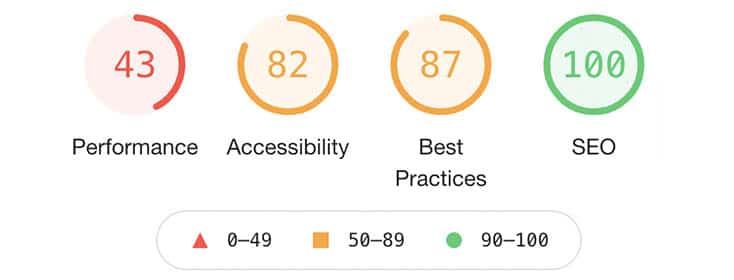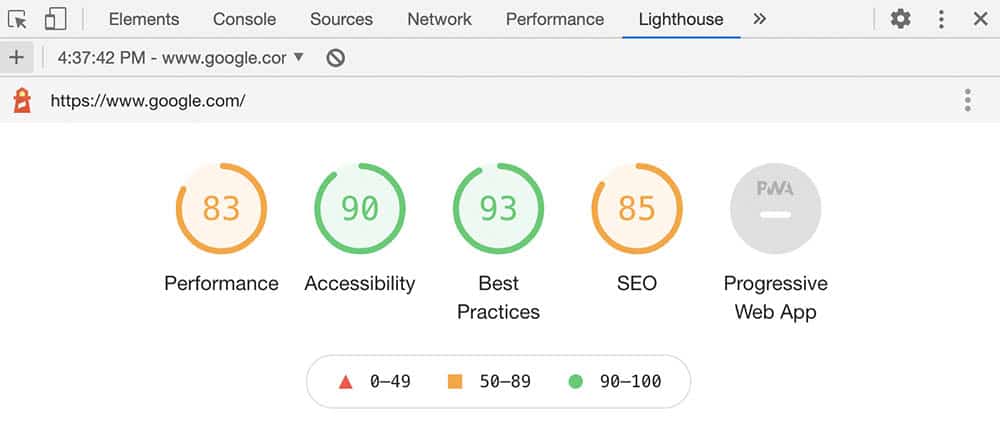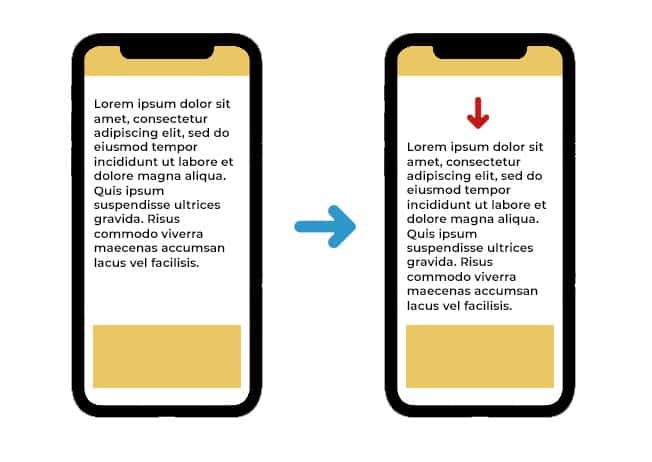How the Best Websites are Handling Google's Core Web Vitals - and How Yours Can Too
Last updated: May, 2023
Google recently introduced a new ranking signal that has digital marketers and business owners scrambling to improve their websites.
Core Web Vitals are fascinating new metrics that judge the quality of web pages. The update is both innovative and frustrating while representing a big shift in the way Google is looking at websites.
The first search algorithm update that measures these Core Web Vitals rolled out during the summer of 2021. This update impacted search results on mobile devices. A second update which impacted desktop results landed in March of 2022. In May of 2023, Google added a significant a new metric called "Interaction to Next Paint," (INP) to Core Web Vitals.
|
Blue Compass' experts recently recorded a webinar all about Google's Core Web Vitals update! Check out the insights our panel provided as we walk you through what Google's Core Web Vitals are, how they impact websites and how to improve your performance score. This webinar is perfect for marketers, business owners and developers of all skills who are interested in improving their website's SEO. Watch the video, skip ahead to the questions you'd like to learn more about or keep reading to find out more information about Google's Core Web Vitals.
|
Core Web Vitals are measurements Google uses to judge, and ideally, improve websites. These are a big part of what Google calls the "page experience," which is really just Google's way of measuring how usable web pages are for users.
Every web page now has a Core Web Vitals score which primarily measures three things:
- Largest Contentful Paint
This is the speed at which a web page’s content loads. Google wants content to load as soon as possible, preferably in 2.5 seconds or less.
- Interaction to Next Paint
A metric that measures how quickly the page responds to user input. This metric is relatively new and is fully replacing Google's former metric, "First Input Delay," in March 2024.
- Cumulative Layout Shift
This is how many unexpected shifts in the page’s content occur. Google wants as little shifting of web page elements as possible.
 How to Measure Your Website’s Core Web Vitals
How to Measure Your Website’s Core Web Vitals
The best way to measure Core Web Vitals is through Google Lighthouse via Chrome DevTools. Here’s how:
- Visit one of your web pages in an Incognito window of Google’s Chrome browser
- Right click and select “Inspect”
- Click on “Lighthouse” in the top menu
- Click the “Generate Report” button
Note: It’s important to ensure you do this in an incognito window, otherwise stored data may interfere with loading and give you an inaccurate score.
This process will generate four numbers rating your page’s performance, accessibility, best practices, and SEO. Each is rated on a scale of 0 to 100, with 100 being the best. Your Core Web Vitals score is found within the Performance score.

Your website’s Core Web Vitals can be found through Google Search Console as well, but our team has noticed this can occasionally give an inaccurate number as it seems to grab outdated data. We suggest sticking with Google Lighthouse.
This metric is a big deal because it’s very rare for Google to declare an algorithm change before it occurs. This announcement emphasizes the importance of Core Web Vitals and having a quality website, challenges web experts to meet new expectations and is why so many digital marketers are concerned about this algorithm update.
When Core Web Vitals were first announced in May 2020, Google said it would be used as a ranking signal beginning May 2021 (the date has been pushed back to June 2021), giving digital marketers an entire year to make adjustments. If a webpage has a good score, it may receive a rankings boost and possibly a badge icon in mobile search results. These search engine optimization benefits are the reason most digital marketers are so focused on these metrics.
Why is Google Emphasizing Core Web Vitals So Much?
Google is pushing this new metric because it believes it will help create a faster, smoother Internet experience. If a website follows these best practices, it generally results in a better experience for the user. There are so many old, outdated, slow websites with poor user experiences, and Google’s whole business model depends on providing good results to its users.
Google simply benefits when websites improve, and it believes offering a ranking bonus can encourage website owners to adhere to these Core Web Vitals.
It’s best to follow Google’s guidelines and improve your website’s user experience, such as how quickly pages load and mobile-friendliness. Google is currently the king of search and following its best practices is a wise move for any website owner. However, we suggest you don’t blindly follow all of Google’s decrees. Always test and monitor new features and suggestions because Google doesn’t have a perfect record for remaining consistent.
Over the years, our digital marketing team has seen numerous cases where Google has told website owners to do one thing, only to change their stance later.
For instance, a few years ago, Google allowed websites to display longer meta descriptions in its search results. While many websites quickly seized the opportunity to expand their descriptions, we strongly suggested our clients hold off to see if this update was permanent. Sure enough, a couple of months later, Google reversed its decision, going back to the shorter meta description format. Suddenly, the websites that lengthened their descriptions had their new copy cut off in search results.
Our stance is simple: follow Google’s best practices - but not blindly. Always monitor and test Google’s guidelines to ensure they’re accurate and truthful.

Google’s motivations may be noble, but Core Web Vitals have still been frustrating for many web developers. Why? Because Google hasn’t provided a very clear roadmap.
Throughout late 2020 and the first half of 2021, Google frequently changed the requirements and the measurements of this score. Since expectations keep changing, it’s hard for website owners to keep consistently solid scores.
Our team has updated our development practices to better follow Google’s guidelines, but only to an extent. Core Web Vitals are still young, thus we won’t fully change all our development processes yet just based on Google’s suggestions.
For instance, Google is suggesting websites use next-generation images like JPG 2000. Doing so may improve your web page’s Performance Score, but not all browsers support that image format, so many website visitors won’t even be able to see these images.
Follow the best practices as much as possible, but don’t let Core Web Vitals scare you. Is your site going to plummet in rankings if you don’t have all 100% scores? No! In fact, below is a look at the score of Google.com on mobile. As you can see, currently even Google doesn’t score 100’s.

Having a poor Performance Score isn’t going to remove your site from Google search. In fact, the impact may be minimal to your site. However, it is a good idea to stay on top of this metric and make your site perform as quickly and smoothly as possible. If you can improve these metrics, you have a better chance of getting more attention from both Google and your target audience.
While there are many updates that can improve your website’s Core Web Vitals, here are the three main improvements we’ve found make the biggest impact.
#1: Decrease Third-Party Plugins on Your Website
Your website likely has at least a few third-party plugins or tracking scripts. These are typically bits of javascript code that a developer has input on certain pages of your site. Examples include Facebook pixels, Google Tag Manager, Google Analytics, Google’s reCAPTCHA, and Hotjar.
These plugins are often very important for your marketing goals. Still, each one slows down your site’s Largest Contentful Paint (and yes, it’s a bit ironic that adding Google code to your webpage negatively impacts this score that Google invented).
Do an audit of these plugins and remove the ones that aren’t vital. Also, check to see if there are newer versions of each plugin that may load faster. For instance, we found that Google’s reCAPTCHA version 2 was really slowing down a web page’s loading, so we upgraded to reCAPTCHA version 3 and found it loaded much faster.
#2: Decrease the File Size of Your Website’s Images
Ensure the images on your website are the proper dimensions and adequately compressed. A 5 mb image, for instance, is simply too big for your website and creates load times that will hurt your metrics and cause visitors to leave. As a general rule, try to keep each of your images under 100 kb. Our experts have made it easier for websites to keep their images SEO compliant with our Responsive Image Generator Tool.
Google also suggests your images load asynchronously via lazy loading. We’ve seen this practice significantly improve Performance Scores.
#3: Eliminate Any Unnecessary Shifts in Content on Your Website
Many websites use animations to move content around the page. Google suggests avoiding this because it can cause someone to click on something accidentally as the shift occurs. Try to avoid content that moves from one point of the page to another (ironically, this is something that Google itself is guilty of in some of its search results).

Reach Out to Our Digital Experts
Our team of developers and digital marketers have spent hundreds of hours improving Core Web Vitals, user experiences and SEO. We’re happy to give you a hand with your website and answer any questions you have! Please reach out to our team of search engine optimization experts in Des Moines and let us know how we can assist.
Drew Harden
CEO and Co-Founder of Blue Compass, Drew Harden has grown and guided the company from a two-person startup in 2007 to one of the Midwest's leading digital marketing companies today. He's a published author, has been cited by PR News and USA Today, and has led web projects that have been honored by organizations like Adobe and American Design Awards.